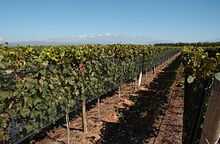Chakana wines
 | |
| Winery | |
| Founded | May 2nd, 2002 |
| Founder | Juan Pelizzatti |
| Headquarters | Argentina |
Area served | United States, Europe, Argentina |
| Website | http://www.chakanawines.com.ar/ |
Chakana Winery was founded on May 2, 2002 in Agrelo, Lujan de Cuyo, Mendoza province, Argentina.[1] Its founder was Juan Pelizzatti.
Their wines come in three different ranges: Maipe (fresh fruit forward wines for every day consumption), Maipe Reserve (complex, barrel aged varietal wines) and Chakana Estate. In 2011 Chakana won one of the three golden medal - best in class awards from the International Wine and Spirit Competition (IWSC) for its Chakana Reserve Malbec 2010.[2] This allowed the winery to compete for Argentinean Producer of the Year Trophy, which took place on November 16 in London.[3]
Team
- Managing Partner: Juan Pelizzatti
- Winemaking Consultant: Alberto Antonini
- Winemaker: Gabriel Bloise
- Manager Américas: Gonzalo Pérez Cerini
- Manager Europe, Asia and Brazil: Francisco García Burgos
- Administration: Cristóbal Valero
- Enology: Liliana Lannizzotto
- Viticulture Consultant: Santiago Mayorga
- Production: Darío Failla
- Logistics: Eliana Martinez
Chakana Wines Origins

Chakana, the company, was founded on May 2, 2002.
After a beginning as a family estate in the middle of the Argentine financial crisis of those years, Chakana started its exports from zero in 2004, to become a 1,5 million bottle company in 2011 with more presence in more than 25 countries worldwide.
In October 2009, a local fund composed of high profile local investors took shares of the company. The purpose of both parties is to bring Chakana to the next level and become one of the main players in Argentina’s wine portfolio.[4]
Location
Chakana wines are made from grapes grown on a 150 ha estate in Lujan de Cuyo, at 960 mts above sea level.
The winery, in Agrelo, has 2 million liter capacity. It has been designed with very small tanks to maintain the identity of each soil parcel. The winemaking process is based on a very careful management of grape and wine in each production stage.
Vineyards and Soils

Chakana vineyards are orientated 45 degrees north west to maximize fruit expression. This also is a surprising example of synchronicity, as this is the exact route that the Andean development chose.
This line was named by the Andean natives as the Viracocha line, or the line of truth of the Incas. Following this line all main Inca centers can be found, from the origins on the Titicaca lake and Tiwanaku to Cuzco. The planting direction in Chakana was chosen to avoid sunburn of the grapes during peak temperature hours, as canopy shades the bunches.
Soils: Chakana prefers alluvial soils of clay loam to sandy loam texture, with round stones at the bottom between 50 and 100 cm and excellent drainage. The best parcels in Agrelo, Mayor Drummond and Altamira feature these conditions that offer round tannins, fantastic structure and full ripeness.
Climate: Lujan de Cuyo and Uco Valley offer all year round dry conditions with extreme thermal amplitude that promote aromatic compounds in wines.
Irrigation: Drip irrigation is used in all of our vineyards as a way to control the growing cycle and make a rational use of water. Winery effluents are neutralized and reused in vineyard irrigation with no impact on the environment.
Terroir Concept

In the past ten years, technology has much improved terroir selection. Based on soil property measurements and leaf color spectrometry, it is possible to map vineyards in Geographical Information Systems (GIS). Then micro-terroirs of homogenous properties can be identified for separate and personalized management. In this way, average quality can be differentiated between very high and very low, allowing for the creation of extremely high quality wines and the improvement of wines of lesser quality.
This methodology is key to the creation of Chakana wines, as a result of our work with Chilean terroir expert Pedro Parra.[5] Pedro has been involved with top wineries in Chile, California, Tuscany and Argentina to help them identify terroirs of superior potential.
Winery
The winery, in Agrelo, has 2 million liter capacity. It has been designed with very small tanks to maintain the identity of each soil parcel. The winemaking process is based on a very careful management of grape and wine in each production stage.
References
- ↑ "Chakana Wines History". Retrieved 28 June 2011.
- ↑ "Wine Details: Chakana Reserve Malbec 2010". Retrieved 11 January 2012.
- ↑ "Chakana achieved global recognition (in spanish)". Retrieved 11 January 2012.
- ↑ "Looking for good grapes (in spanish)". Retrieved 11 January 2012.
- ↑ "Pedro Parra: breaking new ground". Retrieved 28 June 2011.